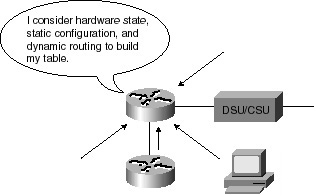Monitoring Troubleshooting an OSPF Network
Table 8-14 describes some fields that are useful in a troubleshooting environment.
show ip ospf virtual-links Command To display parameters about and the current state of OSPF virtual links, use the show ip ospf virtual-links EXEC command. This command provides you with detailed information regarding OSPF virtual links. The actual information output from the command is defined in the example that follows. Usage Guidelines: The information displayed by show ip ospf virtual-links is useful in debugging OSPF routing operations. Example: OSPF_Router# show ip ospf virtual-links Virtual Link to router 160.89.101.2 is up Transit area 0.0.0.1, via interface Ethernet0, Cost of using 10 Transmit Delay is 1 sec, State POINT_TO_POINT Timer intervals configured, Hello 10, Dead 40, Wait 40, Retransmit 5 Hello due in 0:00:08 Adjacency State FULL Table 8-15 describes some fields that are useful in a troubleshooting environment.
show ip ospf summary-address Command Example syntax for the show ip ospf summary-address command is as follows: AST7401#sho ip ospf summary-address OSPF Process 5774, Summary-address Troubleshooting OSPFThis section deals with the inevitable network routing problems. These problems can take many forms, from straightforward loss of connectivity to the more complex routing loops. Even though additional problems exist, such as access list configuration, buffer usage, and queue sizes, they are beyond the scope of this book. The reader is referred to CCO (http://www.cisco.com) for information regarding these subjects. This section provides a variety of resources that can assist in resolving these issues and briefly mentions other issues that are not within the scope of this book. As with any potentially complex problem, certain techniques or methodology have evolved to deal with troubleshooting network-related problems. This troubleshooting methodology is not only applicable to OSPF, it can also be used to assist you with any network problem. As this book deals primarily with OSPF, a routing protocol, take a minute to review how and what the routing process uses for sources of input on a larger scale (that is, not just OSPF LSAs). This information will greatly assist you as routing problems can be many layered or give you false indications. For purposes of the discussion here, consider how Cisco routers build their IP routing tables. Figure 8-2 illustrates an example of the many types of inputs into the routing process that are discussed.
Proper routing will be achieved based upon the following sources of information gained from the network:
| ||||||||||||||||||||||||||||||||||||||||||||||
EAN: 2147483647
Pages: 200
